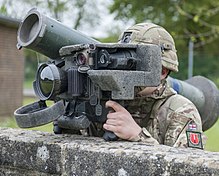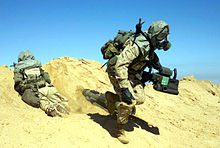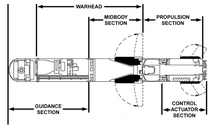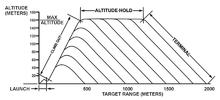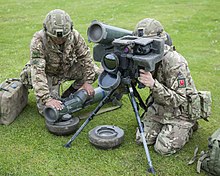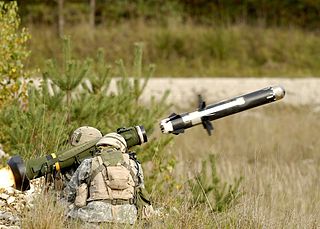
An anti-tank guided missile (ATGM), anti-tank missile, anti-tank guided weapon (ATGW) or anti-armor guided weapon is a guided missile primarily designed to hit and destroy heavily armored military vehicles. ATGMs range in size from shoulder-launched weapons, which can be transported by a single soldier, to larger tripod-mounted weapons, which require a squad or team to transport and fire, to vehicle and aircraft mounted missile systems.

The AGM-114 Hellfire is an American air-to-surface missile (ASM) first developed for anti-armor use, later developed for precision drone strikes against other target types, especially high-value targets. It was originally developed under the name "Heliborne laser, fire-and-forget missile", which led to the colloquial name "Hellfire" ultimately becoming the missile's formal name. It has a multi-mission, multi-target precision-strike ability and can be launched from multiple air, sea, and ground platforms, including the MQ-1 Predator and MQ-9 Reaper. The Hellfire missile is the primary 100-pound (45 kg) class air-to-ground precision weapon for the armed forces of the United States and many other nations. It has also been fielded on surface platforms in the surface-to-surface and surface-to-air roles.

The MIM-104 Patriot is a surface-to-air missile (SAM) system, the primary such system used by the United States Army and several allied states. It is manufactured by the U.S. defense contractor Raytheon and derives its name from the radar component of the weapon system. The AN/MPQ-53 at the heart of the system is known as the "Phased Array Tracking Radar to Intercept on Target," which is a backronym for "Patriot". In 1984, the Patriot system began to replace the Nike Hercules system as the U.S. Army's primary high to medium air defense (HIMAD) system and the MIM-23 Hawk system as the U.S. Army's medium tactical air defense system. In addition to these roles, Patriot has been given a function in the U.S. Army's anti-ballistic missile (ABM) system. As of 2016, the system is expected to stay fielded until at least 2040.

The MGM-140 Army Tactical Missile System is a tactical ballistic missile designed and manufactured by the US defense company Ling-Temco-Vought (LTV), and later Lockheed Martin through acquisitions. It uses solid propellant, is 13 feet (4.0 m) long and 24 inches (610 mm) in diameter, and the longest-range variants can fly up to 190 miles (300 km). The missiles can be fired from the tracked M270 Multiple Launch Rocket System (MLRS) and the wheeled M142 High Mobility Artillery Rocket System (HIMARS).

The BGM-71 TOW is an American anti-tank missile. TOW replaced much smaller missiles like the SS.10 and ENTAC, offering roughly twice the effective range, a more powerful warhead, and a greatly improved semi-automatic command to line of sight (SACLOS) that could also be equipped with infrared cameras for night time use.

The Mk 153 Shoulder-Launched Multipurpose Assault Weapon (SMAW) is a smoothbore shoulder-fired rocket launcher. It is a portable assault weapon and has a secondary anti-armor ability. Developed from the B-300, it was introduced to the United States Armed Forces in 1984. It has a maximum effective range of 500 metres (550 yd) against a tank-sized target.

The M47 Dragon, known as the FGM-77 during development, is an American shoulder-fired, man-portable anti-tank guided missile system. It was phased out of U.S. military service in 2001, in favor of the newer FGM-148 Javelin system.

The M270 Multiple Launch Rocket System is an American armored self-propelled multiple launch rocket system.

The Saab Bofors Dynamics NLAW, also known as the MBT LAW or RB 57, is a fire-and-forget, lightweight shoulder-fired, and disposable (single-use) line of sight (LOS) missile system, designed for infantry use. The missile uses a soft-launch system and is guided by predicted line of sight (PLOS). It can carry out an overfly top attack (OTA) on an armoured vehicle, or a direct attack (DA) on structures and non-armoured vehicles.

The Avenger Air Defense System, designated AN/TWQ-1 under the Joint Electronics Type Designation System, is an American self-propelled surface-to-air missile system which provides mobile, short-range air defense protection for ground units against cruise missiles, unmanned aerial vehicles, low-flying fixed-wing aircraft, and helicopters.
The FGM-172 SRAW, also known as the Predator SRAW, was a lightweight, close range missile system produced by Lockheed Martin, developed by Lockheed Martin and Israel Military Industries. It is designed to complement the FGM-148 Javelin anti-tank missile. The Predator had a longer range and was more powerful than the AT4 that it was designed to replace, but had a shorter range than the Javelin.
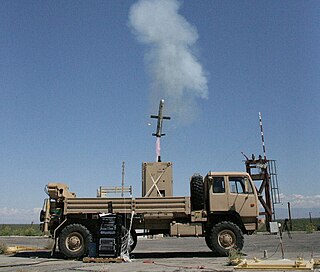
The Non-Line of Sight Launch System (NLOS-LS) was a self-contained missile launcher system that was under development by NETFIRES LLC, a partnership between Lockheed Martin and Raytheon. Each Container Launch Unit (CLU) holds 15 missiles, and a self-locating networked communications system. CLUs can be linked for coordinated launching, with the missiles fired and controlled remotely via autonomous vertical launch. The weapon is roughly 2 metres tall.

Spike is an Israeli fire-and-forget anti-tank guided missile and anti-personnel missile with a tandem-charge high-explosive anti-tank (HEAT) warhead. As of 2007, it is in its fourth generation. It was developed and designed by the Israeli company Rafael Advanced Defense Systems. It is available in man-portable, vehicle-launched, helicopter-launched and maritime variants.

The Type 01 LMAT is a Japanese man-portable fire-and-forget anti-tank missile. Development began in 1993 at Kawasaki Heavy Industries and was accepted into service in 2001. During development, the missile was designated with the codename XATM-5. Later it was known briefly as the: ATM-5.

The AGM-176 Griffin is a lightweight, precision-guided munition developed by Raytheon. It can be launched from the ground or air as a rocket-powered missile or dropped from the air as a guided bomb. It carries a relatively small warhead, and was designed to be a precision low-collateral damage weapon for irregular warfare. It has been used in combat by the United States military during the War in Afghanistan.

The AeroVironment Switchblade is a miniature loitering munition designed by AeroVironment and used by several branches of the United States military. Small enough to fit in a backpack, the Switchblade launches from a tube, flies to the target area, and crashes into its target while detonating its explosive warhead. The name Switchblade comes from how the spring-loaded wings are folded inside a tube and flipped out once released.

The Akeron MP, formerly known as MMP is a French fifth generation man-portable anti-tank guided missile system. Featuring a fire-and-forget capability, it also integrates command guidance in both lock-on before launch (LOBL) and lock-on after launch (LOAL) firing modes for visible targets and non-line-of-sight use respectively. The latter two modes incorporate retargeting, i.e. the ability to redirect the missile in flight towards another target such as an unexpected threat or a new and more valuable enemy asset spotted, as well as aim point selection and mission abort features.
The Pike is a precision-guided mini-missile or grenade munition designed by Raytheon. It is a 40 mm guided munition that can be fired from the barrel of a Heckler & Koch M320 Grenade Launcher Module and Enhanced Grenade Launching Module (EGLM) like a standard 40mm grenade, but is powered by a rocket motor to propel it 2,000 m to give infantrymen improved extended-range precision capabilities. The weapon uses a digital, semi-active laser seeker to guide itself to within five meters of the target; it can operate in a two-man shooter/spotter team or by the grenadier alone lazing after firing, as it can fly for 15 seconds before homing in. When fired, Pike has a small propellant to "kick" it 2.5–3 m (8.2–9.8 ft) out of the tube before the nearly smokeless motor ignites, and range is dependent on firing angle. The munition is effective against fixed and slow-moving mid-range targets, using a 6⁄10 lb blast fragmentation warhead with a 10-meter lethality radius. Raytheon developed the weapon for three years in collaboration with Nammo Talley, which developed the warhead and propulsion system. The Pike is intended to be more accurate with a longer range than rocket propelled grenades (RPGs) and standard rifle grenades, while being far lighter and more cost-effective than current infantry guided weapons like the $78,000 each FGM-148 Javelin. Further improvements could include different fuses, multiple-round simultaneous programming and targeting with data-link capabilities, and platform integration onto small boats, vehicles, and small unmanned aerial vehicles (UAVs). Pike weighs 1.7 lb (0.77 kg) and is 16.8 in (43 cm) long, too long to fit in the breech of the M203 grenade launcher. At AUSA 2015, Raytheon revealed they had performed two successful test firings of the Pike.
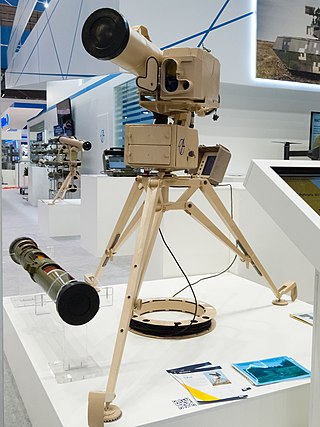
The Skif, also known as the Stugna-P or Stuhna-P, is a Ukrainian anti-tank guided missile (ATGM) system developed in the early 2010s by the Luch Design Bureau, a unit of UkrOboronProm. The initial guidance device PN-S (ПН-С) of the Skif was developed and manufactured by Belarusian design bureau Peleng based in Minsk.

The MPATGM or man portable anti-tank guided missile, is an Indian third generation fire-and-forget anti-tank guided missile (ATGM) derived from India's Nag ATGM. As of 2022, it is being developed by the Defence Research and Development Organisation (DRDO) in partnership with Indian defence contractor VEM Technologies Private Limited.

